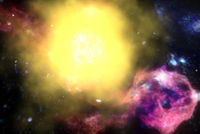Hology
Hology is the scientific study of holes in which holes are classified into different categories and defined.
Laws of Hology[edit | edit source]
- A hole is the volume of the holeant encircled by a holer
- The holer of a hole must be a matter (solid, liquid, gas)
- The hole is not necessary to be of a spherical or circular shape
- The holer must surround the contained holeant
- A hole must be three-dimensional
Holeants[edit | edit source]
The existence of the holeant is defined as the difference of molecular or atomic composition when compared to the holer of the holeant. The holeant does not necessarily need to have a uniformed structure of atoms to be considered as a top-level holeant. The holeant can consist of several smaller holeants, called sub-holeants, which may or may not have the same atomic composition as the holer. The holer, much like its holeant and subsequent sub-holeants, also does not have need to have a uniformed structure throughout the volume in which it occupies.
Classification of Holes[edit | edit source]
- Holes
- Real holes
- Visible holes
- Natural holes - Interior of caves
- Man-made holes - Interior of houses
- Invisible holes
- Natural holes - Mixed air in the air
- Man-made holes - The ozone layer opening to space
- Visible holes
- Theoretical holes - Holes that broke the Law(s) of Hology but are believed to be so
- Visible holes
- Natural holes - Black holes
- Man-made holes - Pictures of caves on screen, print
- Invisible holes
- Natural holes
- Man-made holes - Imagination
- Visible holes
- Real holes
Example[edit | edit source]
A paper has 2 holes (Hole A & B) punched with a picture of a hole (Hole C) on it. Hole A is surrounded by the paper substance, Hole B is only half surrounded and Hole C is also surrounded. Following the Law of Hology, Hole A is a real visible man-made hole as Hole A is three-dimensional and is surrounded by a holer, the paper. Hole B, however, is not. Though being three-dimensional, it is not surrounded and therefore it is not a hole. It can be a theoretical visible man-made hole. Hole C may be surrounded by a holer but it is virtual. A picture is not three-dimensional and therefore Hole C is a theoretical visible man-made hole.
Frequent mistakes[edit | edit source]
Many think that a black hole is a hole but by following the laws of Hology that a holer must be a matter and the holer of the black hole (outer space vacuum) is not a matter and therefore a black hole is not a real hole.
Saying that a donut only has 1 hole is also another frequent mistake. According to the laws of Hology, a hole is the volume of the holeant encircled by a holer. However, there are more than 1 holeant and more than 1 holer as within the donut itself, there are sugar, flour, yeast and many other substances. These may be the substances of the holer surrounding the opening which is the air (holeant) but these substances are able to form more holes within the different types of substances. They may be holers themselves as well, surrounding another type of substance and therefore creating more real holes. Finally, it is a fact that a donut has more than one hole.
Using the laws of Hology, some may conclude that the Earth is actually a hole in the space. This is actually wrong as well, as the outer space is vacuum, meaning that there is no matter in it. If the outer space does not actually have any matter within it, it cannot be assumed as the holer of the Earth (holeant) and therefore Earth will not be a hole in space.
Degrees[edit | edit source]
There are a few places in the world where someone can take up a degree in Hology.
- Uncyclopedia's Online Standardized Tests (run and operated by computers)
- The Theoretical Hole School (commonly known as the Black Hole School)
- The Real Hole School (commonly known as the Inner Core School)
- The Arkman,Sedgewick,&Stearn(A.S.S.)Hology Institution
